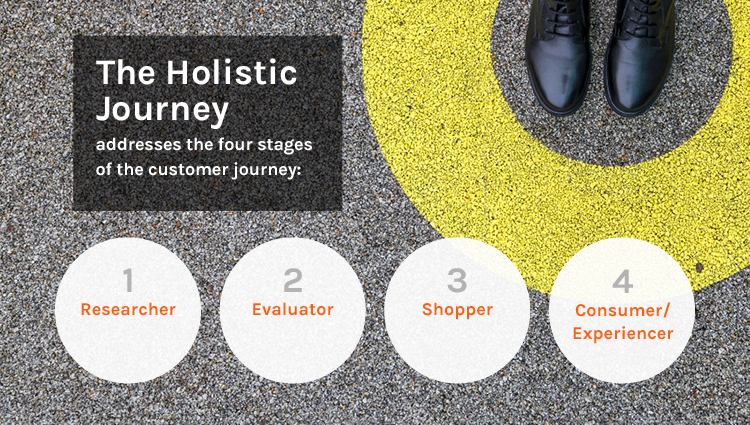Customer Journey research uncovers useful insights into the complexities of how your consumers or clients interact with your brand. Although the journey varies for each brand or product, the research approach has elements that are shared across diverse industries.
The journey, with all of its decisions, touchpoints, and influencers, is really a study of the human perspective. Consider the contrasting processes involved in purchasing a car, selecting an oven, or engaging a financial advisor; each is laden with distinct considerations. This complexity further extends to consumer-packaged goods (CPG), an arena where decisions are about anything from more emotional purchases such as infant formula to everyday choices like toothpaste. The spectrum widens when distinguishing between services and products, as hiring a financial advisor involves different criteria than a straightforward product purchase.
Despite this diversity, a common thread is present: understanding how customer-centric your approach is by exploring the journey’s inner workings, which includes factors such as price points, commitment levels, risk, and influential touchpoints. Navigating this intricate matrix demands a nuanced research approach that acknowledges the uniqueness of each scenario, all while recognizing the fundamental principles that underlie the dynamics of human decision-making.
Customer Journey insights dig into the nuances to deliver actionable strategies.
While making a conscious choice to invest our hard-earned dollars, we move fluidly between evaluating our options to active shopping. Customer Journey research trains an eye on what is most important during critical moments in the journey by exploring a wide range of factors that influence behavior.

The Holistic Journey approach (which applies to most industries and categories) looks at four roles people move in and out of as they consider a purchase:
- Researcher: Gathering information on a product or service.
- Evaluator: Actively making an assessment.
- Shopper: Moving with more intention toward the path-to-purchase.
- Consumer/Experiencer: Using the product or service and making recommendations about it.
When should you consider a Customer Journey research?
Customer Journey research provides valuable insights into customer or client needs. Research is tailored to meet the specific needs of businesses in the B2B or B2C space with a clear and consistent goals of learning what will resonate best with customers to drive growth.
Before exploring the journey, make sure you’re looking at the right map.
An articulated Customer Journey program is one of eight strategic pillars in our Brand Growth Navigator approach.
Understanding the steps consumers take before making a purchase decision is vital, but before you move into a Customer Journey research program, it is important to make sure you have a clear understanding of what your brand means to customers overall. For example, is your communication strategy aligned with the decision-making process? Do you understand how your brand can meet opportunities and customer needs? And do you have a current and relevant picture of your brand’s strengths and weaknesses from the customer’s perspective?
This foundational knowledge will help to frame the right research path for customer exploration.
How an understanding of the Customer Journey influences overall brand health and growth.
The Customer Journey is not just about recognizing pain points and moments of meaning; it’s also a pivotal strategy for overall brand health. Customer journey-mapping provides a dynamic perspective, revealing the intricate flow of customer experiences, from highs to lows, including critical pain points. Breaking down the customer’s journey into individual interactions enhances the visibility of needs and emotions, offering marketers valuable insights into those “moments of meaning” where brands can truly engage customers. This mapping serves as a springboard for brand loyalty by presenting opportunities to maximize market share, minimize churn, and bolster brand equity. This approach can be particularly important for companies with large product portfolios, because it can help them develop strategies specific to each product or service line.
Knowing how the Customer Journey intersects with the broader brand experience is crucial. By linking the journey to performance metrics through voice of customer (VoC) programs, organizations can generate insights that attract and retain customers, thereby driving revenue growth and increasing ROI. Unlike traditional funnel approaches, the Customer Journey recognizes the brand relationship as a complex, intertwined process with key moments of truth dispersed between pre- and post-purchase phases.
Our approach to Customer Journey research is grounded in activation strategy.
Our process is built on ensuring that the research insights will be used to build strategic activation plans. From early in our engagement, we host conversations with cross-functional teams to gain a deep understanding of how teams will use the insights to enrich their Customer Journey programs.
To ensure we’re building the appropriate activation framework, we:
- Define research goals and desired outcomes clearly.
- Involve your insights team and external partners early on to leverage existing knowledge and design effective research.
- Start with broad touchpoints by conducting early-stage Qualitative discussions with customers to gain a comprehensive view of their experiences.
- Use customer testimonials to help strategy decision-makers connect directly with customers.
- Facilitate co-creation workshops among internal teams to ensure collaboration and alignment across different departments affected by Customer Journey insights.
These methodologies combine to ensure you can represent your brand to customers accurately across all touchpoints.
The role of VoC in guiding action and influencing leadership.
Customer stories and the VoC are integral to shaping actionable insights and influencing leadership decisions. Customer testimonials, quotes, or videos bridge the gap between data and its real-world implications, enhancing tangibility for diverse teams.
Whether it’s analytical or product-oriented teams that are being engaged, customer stories complement data, adding depth and context. They serve as a continuous reference point, keeping the VoC alive within the organization and guiding effective decision-making. Going beyond reporting, these stories contribute to embracing new ideas, adapting to change, and moving teams from insights, and they help us guide teams through activation.
The role emotions play in final decisions.
You can build stronger connections with customers when you know more about their emotional states and triggers. The correlation between what consumers say and what they do can be tenuous, as human behavior is often rooted in the emotional, noncognitive dimensions of our brains. Today’s consumers, bombarded with choices and marketing messages, present a unique challenge for brands striving to capture attention and foster loyalty.
To truly grasp the emotional underpinnings of consumer choices, we must use unconventional research methods. Techniques such as sharing metaphors, using biometric measurements, and employing implicit choice methodologies unveil raw emotional responses and anticipated behaviors. Observing consumer behavior in unobtrusive ways, through passive digital metering and voice-activated devices, provides real-time insights across multiple devices and environments.
Identifying deeper emotions and behaviors leads to the creation of effective strategies for product development and positioning. Learn more about the specific methods we use to uncover emotional aspects of consumer choices.
Decision Pathways™ analysis provides a framework for navigating customer choices.
Decision pathways are dynamic and nonlinear, moving seamlessly between roles such as researcher, evaluator, shopper, and consumer. The resulting flexibility allows individuals to transition between these roles at any point in their decision-making journey. The process is not strictly linear; for example, a person might start researching a product, then shift to evaluation based on a friend’s experience, and later transition to shopping or consuming. The duration of each role can vary, with some decisions requiring extended periods of research and evaluation, whereas others, like impulse purchases, happen swiftly. Our Decision Pathway™ methodology is designed to Quantitatively analyze and identify common consumer pathways within specific contexts, such as automotive. By understanding these prevalent pathways, marketers can tailor their strategies to align with consumer behaviors, making the decision-making process more predictable and actionable.
Blending Qualitative and Quantitative research delivers rich, actionable data.
Combining immersive research with Quantitative findings helps us deliver clearer, more strategic insights. Immersive, or Qualitative, research reaches deeply into consumer opinions to identify gaps, explore solutions to consumer pain points, and develop on-target messaging, resulting in:
- Contextual insights: Immersive sessions alongside Quantitative research enhance data understanding, offering insights beyond Quantitative
- Unexpected discoveries: Respondent stories can reveal unforeseen insights that explain gaps and add relevance.
- Explanations of the “why”: Immersive research addresses issues, uncovering the “why” behind shifts in behavior or changing attitudes.
- Sentiment behind the data: Qualitative research complements structured Quantitative data by connecting the numbers to real sentiments to explain pain points and needs.
Learn more about our approach to delivering report stories that build Qualitative and Quantitative results into a structured narrative.
Our role is to help clients activate our insights to create an optimized Customer Journey.
When you know what motivates people, you can meet their needs. Uncovering the emotion behind decisions takes extra steps but leads to insights that help you build truly effective activation strategies.
Our approach to activation is to work with teams throughout the research stages, and particularly as the findings come in, to identify key themes, understand motivations and triggers, and discern the reasons behind purchase decisions. These are the keys to successful Customer Journey activation.
We guide teams through the research, to ensure they will get answers to the questions they’re asking about their customers and help them develop successful action plans. For example, when the research findings are in, we invite teams from across the organization to a Looking Glass™ workshop to review the overall findings and explore specific insights in depth. This approach helps cross-functional teams find connection points and gives each stakeholder time to digest the findings and begin making clear and actionable plans based on those findings. We maintain a connection with teams post-workshop, helping them develop specific plans and suggesting key performance indicators they might use to track their activation strategies.
The combination of story-driven reports and activation integration with teams helps brand teams develop a clear picture of how their customers move through the journey to arrive at purchase decisions.
Ready to leverage Customer Journey insights for your brand?






